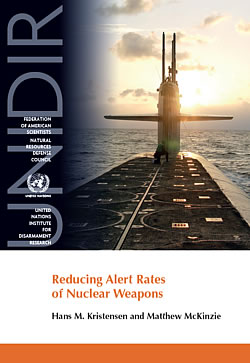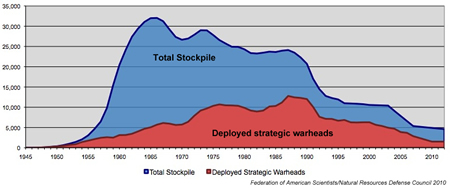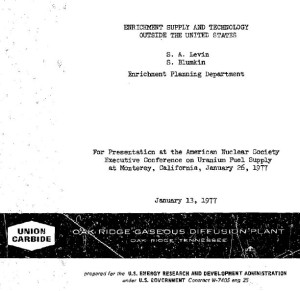Nuclear Notebook: French Nuclear Weapons, 2023
The FAS Nuclear Notebook is one of the most widely sourced reference materials worldwide for reliable information about the status of nuclear weapons and has been published in the Bulletin of the Atomic Scientists since 1987. The Nuclear Notebook is researched and written by the staff of the Federation of American Scientists’ Nuclear Information Project: Director Hans M. Kristensen, Senior Research Fellow Matt Korda, and Research Associate Eliana Johns.
This issue’s column reviews the status of France’s nuclear arsenal and finds that the stockpile of approximately 290 warheads has remained stable in recent years. However, significant modernizations regarding ballistic missiles, cruise missiles, submarines, aircraft, and the nuclear industrial complex are underway.
Read the full “French Nuclear Weapons, 2023” Nuclear Notebook in the Bulletin of the Atomic Scientists, or download a PDF using the button on the left side of this page. The complete archive of FAS Nuclear Notebooks can be found here.
France’s Choice for Naval Nuclear Propulsion: Why Low-Enriched Uranium Was Chosen
This special report is a result of an FAS task force on French naval nuclear propulsion and explores France’s decision to switch from highly-enriched uranium (HEU) to low-enriched uranium (LEU). By detailing the French Navy’s choice to switch to LEU fuel, author Alain Tournyol du Clos — a lead architect of France’s nuclear propulsion program — explores whether France’s choice is fit for other nations.
Nuclear Transparency and the Stockpile Stewardship and Management Plan
 By Hans M. Kristensen
By Hans M. Kristensen
I was reading through the latest Stockpile Stewardship and Management Plan from the National Nuclear Security Administration (NNSA) and wondering what I should pick to critique the Obama administration’s nuclear policy.
After all, there are plenty of issues that deserve to be addressed, including:
– Why NNSA continues to overspend and over-commit and create a spending bow wave in 2021-2026 in excess of the President’s budget in exactly the same time period that excessive Air Force and Navy modernization programs are expected to put the greatest pressure on defense spending?
– Why a smaller and smaller nuclear weapons stockpile with fewer warhead types appears to be getting more and more expensive to maintain?
– Why each warhead life-extension program is getting ever more ambitious and expensive with no apparent end in sight?
– And why a policy of reductions, no new nuclear weapons, no pursuit of new military missions or new capabilities for nuclear weapons, restraint, a pledge to “put an end to Cold War thinking,” and the goal of disarmament, instead became a blueprint for nuclear overreach with record funding, across-the-board modernizations, unprecedented warhead modifications, increasing weapons accuracy and effectiveness, reaffirmation of a Triad and non-strategic nuclear weapons, continuation of counterforce strategy, reaffirmation of the importance and salience of nuclear weapons, and an open-ended commitment to retain nuclear weapons further into the future than they have existed so far?
What About The Other Nuclear-Armed States?
Despite the contradictions and flaws of the administration’s nuclear policy, however, imagine if the other nuclear-armed states also published summaries of their nuclear weapons plans. Some do disclose a little, but they could do much more. For others, however, the thought of disclosing any information about the size and composition of their nuclear arsenal seems so alien that it is almost inconceivable.
Yet that is actually one of the reasons why it is necessary to continue to work for greater (or sufficient) transparency in nuclear forces. Some nuclear-armed states believe their security depends on complete or near-compete nuclear secrecy. And, of course, some nuclear information must be protected from disclosure. But the problem with excessive secrecy is that it tends to fuel uncertainty, rumors, suspicion, exaggerations, mistrust, and worst-case assumptions in other nuclear-armed states – reactions that cause them to shape their own nuclear forces and strategies in ways that undermine security for all.
Nuclear-armed states must find a balance between legitimate secrecy and transparency. This can take a long time and it may not necessarily be the same from country to country. The United States also used to keep much more nuclear information secret and there are many institutions that will always resist public access. But maximum responsible disclosure, it turns out, is not only necessary for a healthy public debate about nuclear policy, it is also necessary to communicate to allies and adversaries what that policy is about – and, equally important, to dispel rumors and misunderstandings about what the policy is not.
Nuclear transparency is not just about pleasing the arms controllers – it is important for national security.
So here are some thoughts about what other nuclear-armed states should (or could) disclose about their nuclear arsenals – not to disclose everything but to improve communication about the role of nuclear weapons and avoid misunderstandings and counterproductive surprises:
 Russia should publish:
Russia should publish:
– Full New START aggregate data numbers (these numbers are already shared with the United States, that publishes its own numbers)
– Size and history of overall nuclear weapons stockpile
– Number of history of nuclear warhead dismantlement (has made statements about percentage reductions since 1991 but not disclosed numbers or history)
– Basic overview of which nuclear forces are nuclear-capable (has made some statements about strategic forces but not shorter-range forces)
– Plans for future years force levels of long-range nuclear forces (has made occasional statements about modernizations but no detailed plan)
– Overall status and out-year budgets for nuclear weapons and nuclear forces
 China should publish:
China should publish:
– Size and history of overall nuclear weapons stockpile (stated in 2004 that it possessed the smallest arsenal of the nuclear weapon states but has not disclosed numbers or history)
– Basic overview of its nuclear-capable forces
– Plans for future years force levels of long-range nuclear forces
– Overall status and out-year budgets for nuclear weapons and nuclear forces
 France should publish:
France should publish:
– History of overall nuclear weapons stockpile (has disclosed the size of its nuclear stockpile in 2008 and 2015 (300 weapons), but not the history)
– Number and history of nuclear warhead dismantlement (has declared dismantlement of some types but not history)
(France has disclosed its overall force structure and some nuclear budget information is published each year.)
 Britain should publish:
Britain should publish:
– History of overall nuclear weapons stockpile (has declared some approximate historic numbers, declared the approximate size in 2010 (no more than 225), and has declared plan for mid-2020s (no more than 180), but has not disclosed history)
– Number and history of nuclear warhead dismantlement (has announced dismantlement of systems but not numbers or history)
(Britain has published information about the size of its nuclear force structure and part of its nuclear budget.)
 Pakistan should publish:
Pakistan should publish:
– History of overall nuclear weapons stockpile
– Basic overview of nuclear-capable forces (occasionally declares that a missile test involves nuclear-capable weapon)
– Plans for future years force levels of longer-range nuclear forces
– Overall status and out-year budgets for nuclear weapons and nuclear forces
 India should publish:
India should publish:
– History of overall nuclear weapons stockpile
– Basic overview of nuclear-capable forces (occasionally declares that a missile test involves nuclear-capable weapon)
– Plans for future years force levels of longer-range nuclear forces
– Overall status and out-year budgets for nuclear weapons and nuclear forces
 Israel should publish:
Israel should publish:
…or should it? Unlike other nuclear-armed states, Israel has not publicly confirmed it has a nuclear arsenal and has said it will not be the first to introduce nuclear weapons in the Middle East. Some argue Israel should not confirm or declare anything because of fear it would trigger nuclear arms programs in other Middle Eastern countries.
On the other hand, the existence of the Israeli nuclear arsenal is well known to other countries as has been documented by declassified government documents in the United States. Official confirmation would be politically sensitive but not in itself change national security in the region. Moreover, the secrecy fuels speculations, exaggerations, accusations, and worst-case planning. And it is hard to see how the future of nuclear weapons in the Middle East can be addressed and resolved without some degree of official disclosure.
 North Korea should publish:
North Korea should publish:
Well, obviously this nuclear-armed state is a little different (to put it mildly) because its blustering nuclear threats and statements – and the nature of its leadership itself – make it difficult to trust any official information. Perhaps this is a case where it would be more valuable to hear more about what foreign intelligence agencies know about North Korea’s nuclear arsenal. Yet official disclosure could potentially serve an important role as part of a future de-tension agreement with North Korea.
Additional information:
Status of World Nuclear Forces with links to more information about individual nuclear-armed states.
“Nuclear Weapons Base Visits: Accident and Incident Exercises as Confidence-Building Measures,” briefing to Workshop on Non-Strategic Nuclear Weapons in Europe: Transparency and Confidence-Building Measures in Practice, German Institute for International and Security Affairs, Berlin, 27-28 March 2014.
“Nuclear Warhead Stockpiles and Transparency” (with Robert Norris), in Global Fissile Material Report 2013, International Panel on Fissile Materials, October 2013, pp. 50-58.
The research for this publication was made possible by a grant from the New Land Foundation, and Ploughshares Fund. The statements made and views expressed are solely the responsibility of the author.
Solidarity with Charlie Hebdo? Subscribe!
What can anyone do in response to the horrific murders of twelve persons associated with the French weekly Charlie Hebdo?
One way of expressing solidarity with the victims, and opposition to the killers, would be to purchase a subscription to the satirical (often deliberately offensive) publication, whether for yourself or for a local library.
In the U.S., subscriptions to Charlie Hebdo are conveniently available through Amazon.com (h/t Jack Shafer).
The surviving staff said that next week’s issue will be published on schedule.
Nuclear Modernization Briefings at the NPT Conference in New York

By Hans M. Kristensen
Last week I was in New York to brief two panels at the Third Session of the Preparatory Committee for the 2015 Review Conference of the Parties to the Treaty on the Non-Proliferation of Nuclear Weapons (phew).
The first panel was on “Current Status of Rebuilding and Modernizing the United States Warheads and Nuclear Weapons Complex,” an NGO side event organized on May 1st by the Alliance for Nuclear Accountability and the Women’s International League for Peace and Freedom (WILPF). While describing the U.S. programs, I got permission from the organizers to cover the modernization programs of all the nuclear-armed states. Quite a mouthful but it puts the U.S. efforts better in context and shows that nuclear weapon modernization is global challenge for the NPT.
The second panel was on “The Future of the B61: Perspectives From the United States and Europe.” This GNO side event was organized by the Nuclear Age Peace Foundation on May 2nd. In my briefing I focused on providing factual information about the status and details of the B61 life-extension program, which more than a simple life-extension will produce the first guided, standoff nuclear bomb in the U.S. inventory, and significantly enhance NATO’s nuclear posture in Europe.
The two NGO side events were two of dozens organized by NGOs, in addition to the more official side events organized by governments and international organizations.
The 2014 PREPCOM is also the event where the United States last week disclosed that the U.S. nuclear weapons stockpile has only shrunk by 309 warheads since 2009, far less than what many people had anticipated given Barack Obama’s speeches about “dramatic” and “bold” reductions and promises to “put an end to Cold War thinking.”
Yet in disclosing the size and history of its nuclear weapons stockpile and how many nuclear warheads have been dismantled each year, the United States has done something that no other nuclear-armed state has ever done, but all of them should do. Without such transparency, modernizations create mistrust, rumors, exaggerations, and worst-case planning that fuel larger-than-necessary defense spending and undermine everyone’s security.
For the 185 non-nuclear weapon states that have signed on to the NPT and renounced nuclear weapons in return of the promise made by the five nuclear-weapons states party to the treaty (China, France, Russia, United Kingdom, and the United States) “to pursue negotiations in good faith on effective measures relating to the cessation of the nuclear arms race at early date and to nuclear disarmament,” endless modernization of the nuclear forces by those same five nuclear weapons-states obviously calls into question their intension to fulfill the promise they made 45 years ago. Some of the nuclear modernizations underway are officially described as intended to operate into the 2080s – further into the future than the NPT and the nuclear era have lasted so far.
Download two briefings listed above: briefing 1 | briefing 2
This publication was made possible by a grant from the Ploughshares Fund. The statements made and views expressed are solely the responsibility of the author.
Air Force Briefing Shows Nuclear Modernizations But Ignores US and UK Programs
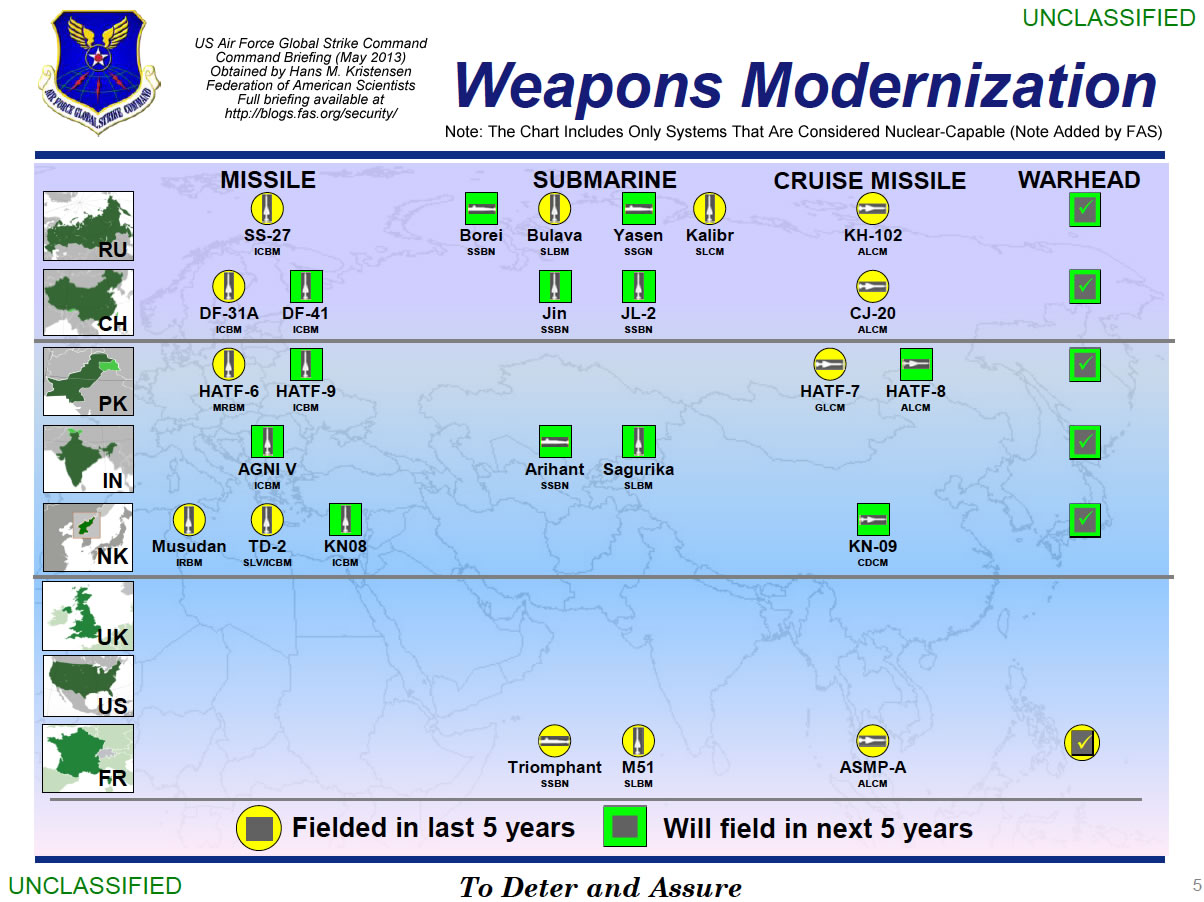
Click to view large version. Full briefing is here.
By Hans M. Kristensen
China and North Korea are developing nuclear-capable cruise missiles, according to U.S. Air Force Global Strike Command (AFGSC).
The new Chinese and North Korean systems appear on a slide in a Command Briefing that shows nuclear modernizations in eight of the world’s nine nuclear weapons states (Israel is not shown).
The Chinese missile is the CJ-20 air-launched cruise missile for delivery by the H-6 bomber. The North Korean missile is the KN-09 coastal-defense cruise missile. These weapons would, if for real, be important additions to the nuclear arsenals in Asia.
At the same time, a closer look at the characterization used for nuclear modernizations in the various countries shows generalizations, inconsistencies and mistakes that raise questions about the quality of the intelligence used for the briefing.
Moreover, the omission from the slide of any U.S. and British modernizations is highly misleading and glosses over past, current, and planned modernizations in those countries.
For some, the briefing is a sales pitch to get Congress to fund new U.S. nuclear weapons.
Overall, however, the rampant nuclear modernizations shown on the slide underscore the urgent need for the international community to increase its pressure on the nuclear weapon states to curtail their nuclear programs. And it calls upon the Obama administration to reenergize its efforts to reduce the numbers and role of nuclear weapons.
Russia
![]()
The briefing lists seven Russian nuclear modernizations, all of which are well known and have been underway for many years. Fielded systems include SS-27 ICBM, Bulava SLBM, Kalibr SLCM, and KH-102 ALCM.
It is puzzling, however, that the briefing lists Bulava SLBM and Kalibr SLCM as fielded when their platforms (Borei SSBN and Yasen SSGN, respectively) are not. The first Borei SSBN officially entered service in January 2013.
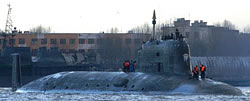
Nuclear Cruise Missile For Yasen SSGN
It is the first time I’ve seen a U.S. government publication stating that the non-strategic Kalibr land-attack SLCM is nuclear (in public the Kalibr is sometimes called Caliber). The first Yasen SSGN, the Severodvinsk, test launched the Kalibr in November 2012. The weapon will also be deployed on the Akula-class SSGN. The Kalibr SLCM, which is dual-capable, will probably replace the aging SS-N-21, which is not. There are no other Russian non-strategic nuclear systems listed in the AFGSC briefing.
A new warhead is expected within the next five years, but since no new missile is listed the warhead must be for one of the existing weapons.
China
![]()
The briefing lists six Chinese nuclear modernizations: DF-31A ICBM, DF-41 ICBM, Jin SSBN, JL-2 SLBM, CJ-20 ALCM, and a new warhead.
The biggest surprise is the CJ-20 ALCM, which is the first time I have ever seen an official U.S. publication crediting a Chinese air-launched cruise missile with nuclear capability. The latest annual DOD report on Chinese military modernization does not do so.
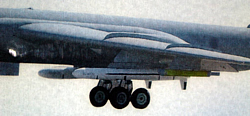
H-6 with CJ-20. Credit: Chinese Internet.
The CJ-20 is thought to be an air-launched version of the 1,500+ kilometer ground-launched CJ-10 (DH-10), which the Air Force in 2009 reported as “conventional or nuclear” (the AFGSC briefing does not list the CJ-10). The CJ-20 apparently is being developed for delivery by a modified version of the H-6 medium-range bomber (H-6K and/or H-6M) with increased range. DOD asserts that the H-6 using the CJ-20 ALCM in a land-attack mission would be able to target facilities all over Asia and Russia (east of the Urals) as well as Guam – that is, if it can slip through air defenses.
The elusive DF-41 ICBM is mentioned by name as expected within the next five years. References to a missile known as DF-41 has been seen on and off for the past two decades, but disappeared when the DF-31A appeared instead. The latest DOD report does not mention the DF-41 but states that, “China may also be developing a new road-mobile ICBM, possibly capable of carrying a multiple independently targetable reentry vehicle (MIRV).” (Emphasis added).
AFGSC also predicts that China will field a new nuclear warhead within the next five years. MIRV would probably require a new and smaller warhead but it could potentially also refer to the payload for the JL-2.
Pakistan
![]()
Pakistan is listed with five nuclear modernizations, all of which are well known: Hatf-8 (Shaheen II) MRBM, Hatf-9 (NASR) SRBM, Hatf-7 (Babur) GLCM, Hatf-8 (Ra’ad) ALCM, and a new warhead. Two of them (Hatf-8 and Hatf-7) are listed as fielded.
The briefing mistakenly identifies the Hatf-9 as an ICBM instead of what it actually is: a short-range (60 km) ballistic missile.
The new warhead might be for the Hatf-9.
India
![]()
India is listed with four nuclear modernizations, all of which are well known: Agni V ICBM, Arihant SSBN, “Sagurika” SLBM, and a new warhead. The U.S. Intelligence Community normally refers to “Sagurika” as Sagarika, which is known as K-15 in India.
Neither the Agni III nor Agni IV are listed in the briefing, which might indicate, if correct, that the two systems, both of which were test launched in 2012, are in fact technology development programs intended to develop the technology to field the Agni V.
The U.S. Intelligence Community asserts that the Agni V will be capable of carrying multiple warheads, as recently stated by an India defense industry official – a dangerous development that could well motivate China to deploy multiple warheads on some of its missiles and trigger a new round of nuclear competition between India and China.
The new warhead might be for the SLBM and/or for Agni V.
North Korea
![]()
North Korea is listed with five nuclear modernizations: Musudan IRBM, TD-2 SLV/ICBM, KN-08 ICBM, KN-09 CDCM, and a warhead.
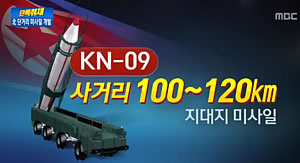
The biggest surprise is that AFGSC asserts that the KN-09 is nuclear-capable. There are few public reports about this weapon, but the South Korean television station MBC reported in April that it has a range of 100-120 km. MBC showed KN-09 as a ballistic missile, but AFGSC lists it as a CDCM (Coastal Defense Cruise Missile).
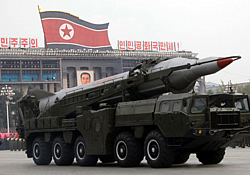
The Musudan IRBM is listed as “fielded” even though the missile, according to the U.S. Intelligence Community, has never been flight tested. In this case, “fielded” apparently means it has appeared but not that it is operational or necessarily deployed with the armed forces.
The Mushudan is listed as “fielded,” similar to the Russian SS-27, even though the North Korean missile has never been flight tested.
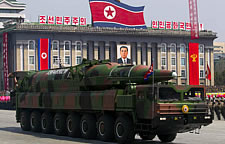
The KN-08 ICBM, which was displayed at the May 2012 parade, was widely seen by non-governmental analysts to be a mockup. But AFGSC obviously believes the weapon is real and expected to be “fielded” within the next five years. There were rumors in January 2013 that North Korea had started moving KN-08 launchers around the country at the beginning of a saber-rattling campaign that lasted through March.
Finally, the AFGSC briefing also predicts that North Korea will field a nuclear warhead within the next five year. Whether this refers to North Korea’s first weaponized warhead or newer types is unclear.
United Kingdom
![]()
The UK section does not include any weapons modernizations, which doesn’t quite capture what’s going on. For example, Britain is deploying the modified W76-1/Mk4A, which British officials have stated will increase the targeting capability of the Trident II D5 SLBM. Accordingly, a warhead icon has been added to the U.K. bar above.
Moreover, although the final approval has not been given yet, Britain is planning construction of a new SSBN to replace the current fleet of four Vanguard-class SSBNs. The missile section is under development in the United States. The new submarine will also receive the life-extended D5 SLBM.
United States
![]()
The U.S. section also does not show any nuclear modernizations, which glosses over important upgrades.
For example, the Minuteman III ICBM is in the final phases of a decade-long multi-billion dollar life-extension program that will extend the weapon to 2030. Privately, Air Force officials are joking that everything except the shell is new. Accordingly, a fielded ICBM icon has been added to the U.S. bar.
Moreover, full-scale production and deployment of the W76-1/Mk4A warhead on the Trident II D5 SLBM is underway. The combination of the new reentry body with the D5 increases the targeting capability of the weapon. Accordingly, a fielded warhead icon has been added to the U.S. bar.
In addition, from 2017 the U.S. Navy will begin deploying a modified life-extended version of the D5 SLBM (D5LE) on Ohio-class SSBNs. Production of the D5LE is currently underway, which will be “more accurate” and “provide flexibility to support new missions,” according to the navy and contractor. Accordingly, a forthcoming SLBM icon has been added to the U.S. bar.
Finally, the United States has begun design of a new SSBN class, a long-range bomber, a long-range cruise missile, a fighter-bomber, a guided standoff gravity bomb, and is studying a replacement-ICBM.
Hardly the dormant nuclear enterprise portrayed in the briefing.
France
![]()
France is listed with four nuclear modernizations, all well known: Triomphant SSBN, M51 SLBM, ASMP-A ALCM, and a new warhead.
The introduction of the ASMP-A is complete but the M51 SLBM is still replacing M45 SLBMs on the SSBN fleet.
The warhead section only appears to include the TNA warhead for the ASMP-A but ignores that France from 2015 will begin replacing the TN75 warhead on the M51 SLBM with the new TNO.
What is Meant by Nuclear and Fielded?
The AFGSC briefing is unclear and somewhat confusing about what constitutes a nuclear-capable weapon system and when it is considered “fielded.”
AFGSC confirmed to me that the slide only lists nuclear-capable weapon systems.
Air Force regulations are pretty specific about what constitutes a nuclear-capable unit. According to Air Force Instruction 13-503 regarding the Nuclear-Capable Unit Certification, Decertification and Restriction Program, a nuclear-capable unit is “a unit or an activity assigned responsibilities for employing, assembling, maintaining, transporting or storing war reserve (WR) nuclear weapons, their associated components and ancillary equipment.”
This is pretty straightforward when it comes to Russian weapons but much more dubious when describing North Korean systems. Russia is known to have developed miniaturized warheads and repeatedly test-flown them on missiles that are operationally deployed with the armed forces.
North Korea is a different matter. It is known to have detonated three nuclear test devices and test-launched some missiles, but that’s pretty much the extent of it. Despite its efforts and some worrisome progress, there is no public evidence that it has yet turned the nuclear devices into miniaturized warheads that are capable of being employed successfully by its ballistic or cruise missiles. Nor is there any public evidence that nuclear-armed missiles are operationally deployed with the armed forces.
Moreover, the U.S. Intelligence Community has recently issued strong statements that cast doubt on whether North Korea has yet mastered the technology to equip missile with nuclear warheads. James Clapper, the director of National Intelligence, testified before the Senate on April 18, 2013, that despite its efforts, “North Korea has not, however, fully developed, tested, or demonstrated the full range of capabilities necessary for a nuclear-armed missile.”
So how can the AFGSC briefing label North Korean ballistic missiles as nuclear-capable – and also conclude that the KN-09 cruise missile is nuclear-capable?
There are similar questions about the determination of when a weapon system is “fielded.” Does it mean it is fielded with the armed forces or simply that it has been seen? For example, how can a North Korean Musudan IRBM be considered fielded similarly to a Russia SS-27 ICBM?
Or how can the Musudan IRBM be identified as already “fielded” when it has not been flight tested and only displayed on parade, when the KN-08 is identified as not “fielded” even though it has also not been flight tested, also been displayed on parade, and even moved around North Korea?
Finally, how can the Russian Bulava SLBM and Kalibr SLCM be listed as “fielded” when their delivery platforms (Borei SSBN and Yasen SSGN, respectively) are listed as not fielded?
These inconsistencies cast doubt on the quality of the AFGSC briefing and whether it represents the conclusion of a coordinated Intelligence Community assessment, or simply is an effort to raise money in Congress for modernizing U.S. bombers and ICBMs.
Implications and Recommendations
There are still more than 17,000 nuclear weapons in the world and all the nuclear weapon states are busy maintaining and modernizing their arsenals. After Russia and the United States have insisted for decades that nuclear cruise missiles are essential for their security, the AFGSC briefing claims that China and North Korea are now trying to follow their lead.
For some, the AFGSC briefing will be (and probably already is) used to argue that nuclear threats against the United States and its allies are increasing and that Congress therefore should oppose further reductions of U.S. nuclear forces and instead approve modernizations of the remaining arsenal.
But Russia is not expanding its nuclear forces, the nuclear arsenals of China and Pakistan are much smaller than U.S. forces, and North Korea is in its infancy as a nuclear weapon state.
Instead, the rampant nuclear modernizations shown in the briefing symbolize struggling arms control and non-proliferation regimes that appear inadequate to turn the tide. They are being undercut by recommitments of a small group of nuclear weapon states to retain and improve nuclear forces for the indefinite future. The modernizations are partially being sustained by non-nuclear weapon states – often the very same who otherwise say they want nuclear disarmament – that insist on being protected by nuclear weapons.
The AFGSC briefing shows that there’s an urgent need for the international community to increase its pressure on the nuclear weapon states to curtail their nuclear programs. Especially limitations on MIRVed missiles are urgently needed. For its part, the Obama administration must reenergize its efforts to reduce the numbers and role of nuclear weapons.
There have been many nice speeches about reducing nuclear arsenals but too little progress on limiting the endless cycle of modernizations that sustain them.
Document: Air Force Global Strike Command Command Briefing
This publication was made possible by grants from the New-Land Foundation and Ploughshares Fund. The statements made and views expressed are solely the responsibility of the author.
PREPCOM Nuclear Weapons De-Alerting Briefing

By Hans M. Kristensen
Greetings from Geneva! I’m at the Palais des Nations for the second Preparatory Committee (PREPCOM) meeting for the 2015 Review Conference of the nuclear Non-Proliferation Treaty (NPT). I was invited by the Swiss and New Zealand UN Missions to brief our report Reducing Alert Rates of Nuclear Weapons.
With me on the panel was Richard Garwin, an FAS board member who for more than five decades has advised U.S. governments on nuclear weapons and other issues, and Gareth Evans, former Australian Foreign Minister and now Chancellor of the Australian National University.
The panel was co-chaired by Ambassador H.E. Dell Higgie, the head of the New Zealand UN Mission and Permanent Representative to the United Nations and Conference on Disarmament, and Ambassador Benno Laggner, the head of the Swiss Foreign Ministry’s Division for Security Policy and Ambassador for Nuclear Disarmament and Non-Proliferation. Switzerland and New Zealand have for several years spearheaded efforts in the United Nations to reduce the alert level of nuclear weapons.
I wrote the de-alerting report together with Matthew McKinzie who directs the nuclear program at the Natural Resources Defense Council. Click to download my briefing slides (7.6 MB) and prepared remarks.
New Report: Reducing Alert Rates of Nuclear Weapons
.By Hans M. Kristensen
The United States and Russia have some 1,800 nuclear warheads on alert on ballistic missiles that are ready to launch in a few minutes, according to a new study published by UNIDIR. The number of U.S. and Russian alert warheads is greater than the total nuclear weapons inventories of all other nuclear weapons states combined.
The report Reducing Alert Rates of Nuclear Weapons is co-authored by Matthew McKinzie from the Natural Resources of Defense Council and yours truly.
France and Britain also keep some of their nuclear force on alert, although at lower readiness levels than the United States and Russia. No other nuclear weapon state has nuclear weapons on alert.
The report concludes that the warning made by opponents of de-alerting, that it could trigger a re-alerting race in a crisis that count undermine stability, is a “straw man” argument that overplays risks, downplays benefits, and ignores that current alert postures already include plans to increase readiness and alert rates in a crisis.
According to the report, “while there are risks with alerted and de-alerted postures, a re-alerting race that takes three months under a de-alerted posture is much preferable to a re-alerting race that takes only three hours under the current highly alerted posture. A de-alerted nuclear posture would allow the national leaders to think carefully about their decisions, rather than being forced by time constraints to choose from a list of pre-designated responses with catastrophic consequences.”
During his election campaign, Barack Obama promised to work with Russia to take nuclear weapons off “hair-trigger” alert, but the 2010 Nuclear Posture Review (NPR) instead decided to keep the existing alert posture. The post-NPR review that has now been completed but has yet to be announced hopefully will include a reduction of the alert level, not least because the Intelligence Community has concluded that a Russian surprise first strike is unlikely to occur.
The UNIDIR report finds that the United States and Russia previously have reduce the alert levels of their nuclear forces and recommends that they continue this process by removing the remaining nuclear weapons from alert through a phased approach to ensure stability and develop consultation and verification measures.
Full report: Reducing Alert Rates of Nuclear Weapons (FAS mirror)
This publication was made possible by a grant from the Swiss Government. General nuclear forces research is supported by the Ploughshares Fund. The statements made and views expressed are solely the responsibility of the authors.
New Article: French Nuclear Modernization

A new report describes worldwide nuclear weapons modernization efforts
By Hans M. Kristensen
The organization Reaching Critical Will has published a collection of articles about the nuclear weapons modernization programs that are underway in the various nuclear weapons states around the world.
My modest contribution is the chapter on France (pages 27-33).
The report – Assuring Destruction Forever – illustrates that although the Cold War nuclear arms race has ended, a global effort to modernize and improve nuclear weapons is in full swing. For some regions (India-Pakistan and India-China) this effort has elements of an arms race, but for most countries it is about extending and improving a nuclear weapons capability indefinitely.
This should remind us why it is increasingly meaningless to assess nuclear arms control progress in numerical terms by comparing the sizes of today’s arsenals with those of the Cold War. Progress increasingly must be measured in constraint: yes, by reducing arsenals further, but perhaps more importantly by curtailing deployments, operations, missions, life-extensions, modernizations and improvements.
Otherwise, the dynamic efforts to extend and modernize the remaining nuclear arsenals may end up working against the nuclear arms control process. Because life-extension and modernization efforts are accompanied by declarations by the nuclear weapon states and alliances about the continued importance of nuclear weapons to national and international security, there is a risk that they will combine to reaffirm and prolong the nuclear weapons era instead of delegitimizing and shortening it.
This publication was made possible by a grant from Carnegie Corporation of New York and Ploughshares Fund. The statements made and views expressed are solely the responsibility of the author.
United States Discloses Size of Nuclear Weapons Stockpile
 |
| The Obama administration has declassified the history and size of the U.S. nuclear weapons stockpile, a long-held national secret. Click image to get the fact sheet. |
By Hans M. Kristensen
The Obama administration has formally disclosed the size of the Defense Department’s stockpile of nuclear weapons: 5,113 warheads as of September 30, 2009.
For a national secret, we’re pleased that the stockpile number is only 87 warheads off the estimate we made in February 2009. By now, the stockpile is probably down to just above 5,000 warheads.
The disclosure is a monumental step toward greater nuclear transparency that breaks with outdated Cold War nuclear secrecy and will put significant pressure on other nuclear weapon states to reciprocate.
The stockpile disclosure, along with the rapid reduction of operational deployed warheads disclosed yesterday, the Obama administration is significantly strengthening the U.S. position at the Nuclear Non-Proliferation Treaty (NPT) Review Conference.
Progress toward deep nuclear cuts and eventual nuclear disarmament would have been very difficult without disclosing the inventory of nuclear weapons.
FAS and others have long advocated disclosure and argued that keeping the size of the nuclear arsenal secret serves no real national security purpose in the post-Cold War era. Now that the size of the nuclear stockpile is no longer a secret, that dismantlement numbers are no longer secret, and the number of deployed strategic warheads is no longer a secret, the United States should also disclose the total number of strategic and non-strategic weapons in the stockpile.
Stockpile History and Forecast
When the Bush administration took office in 2001, the stockpile included 10,526 warheads. In June 2004, the NNSA announced a decision to cut the 2001 stockpile “nearly in half” by 2012. That goal was achieved five years early in December 2007, at which point the White House announced an additional cut of 15 percent by 2012. Once these reductions are completed, the stockpile will include approximately 4,600 warheads, a force level last seen in 1956.
.
The Obama administration has not yet announced a decision to further reduce the nuclear stockpile, but there are several hints in the Nuclear Posture Review (NPR) that it intends to reduce the stockpile further. The NPR states that the United States will be “significantly reducing the size of the technical hedge overall,” a reference to the thousands of non-deployed but intact warheads kept in storage for potential upload back unto missiles and bombers in case of Russia or China building up and to replace warheads that develop technical problems.
The NPR also states that the number of warheads awaiting dismantlement “will increase as weapons are removed from the stockpile under New START.” Since the New START does not require removing weapons from the stockpile – only from strategic delivery vehicles – this is also a reference to further stockpile reductions. One senior official told me that some of these reductions would be made soon.
But the “major reductions in the nuclear stockpile” promised by the NPR appear to be conditioned on “implementation of the Stockpile Stewardship Program and the nuclear infrastructure investments….” If Congress approves these investments, some “hedge” warheads can “be retired along with other stockpile reductions planned over the next decade.”
| Estimated U.S. Nuclear Weapons Inventories, 2010 |
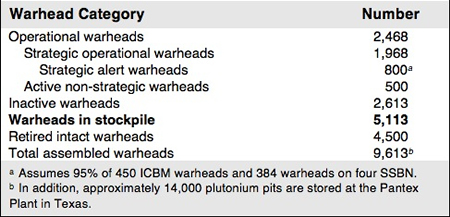 |
| The nuclear stockpile is only a portion of the total U.S. inventory of nuclear weapons. We estimate the total number of assembled warheads is close to 9,600, probably a little less given ongoing dismantlement of retired warheads. |
.
Stockpile Warhead Categories
The stockpile contains many subcategories of warheads. There are two overall categories: active and inactive. The active category includes two subcategories: deployed warheads on missiles and bomber bases and nondeployed warheads in the “Responsive Force” for uploading in case of Russia or China building up or technical failure of deployed warheads. The inactive category includes warheads without limited-life components (such as tritium) in long-term storage.
But since the stockpile is always in a flux with warheads being moved between platforms and maintenance, each of these subcategories have numerous other categories that relate to the readiness of the warheads. According to information obtained from the government, there are four readiness state (RS) categories related to warhead functions:
RS-A: Warheads that may be used for possible wartime employment.
RS-B: Warheads intended to be used for logistical purposes (e.g., LLC exchange (LLCE), repairs, surveillance, transportation, etc.).
RS-C: Warheads intended to be used for QUART replacement.
RS-D: Warheads intended to be used for reliability replacement.
There are also five readiness state categories that relate to the warhead location an maintenance requirements:
RS-1: Active stockpile warheads intended to be located primarily on launchers or at an operational base.
RS-2: Active stockpile warheads intended to be located primarily at either an operational base or depot.
RS-3: Inactive stockpile warheads intended to be located primarily at a depot, have the LLCs removed as soon as logistically practical, require refurbishment, and require reliability and safety assessments.
RS-4: Inactive stockpile warheads intended to be located primarily at a depot, have the LLCs removed as soon as logistically practical, do NOT require refurbishment, but do require reliability and safety assessments.
RS-5: Inactive stockpile warheads intended to be located at a depot, have LCCs removed as soon as logistically practical, do NOT require refurbishment, do NOT require reliability assessments, but do require safety assessments.
Other Countries
The disclosure puts pressure of the other nuclear weapon states to reciprocate. Nuclear weapon states that do not disclose the size of their nuclear arsenals will now be seen as secretive and obstructing nuclear transparency and progress towards deep cuts and eventually disarmament. Some nuclear countries have given ballpark numbers:
The Chinese Foreign Ministry declared in a fact sheet in 2004 that, “Among the nuclear-weapon states, China. . . possesses the smallest nuclear arsenal.” That suggested fewer than 200 operationally available warheads, as declared by Britain in 1998. (See also the latest Nuclear Notebook on China.)
Britain further declared in 2007 that it would “reduce the maximum number of operationally available warheads from fewer than 200 to fewer than 160” by 2007. This suggests that a limited inventory of non-operationally available warheads exists.
France declared in 2008 that its “arsenal will include fewer than 300 nuclear warheads” following a reduction of the bombers. French president Nicolas Sarkozy claimed France was “completely transparent because it has no other weapons beside those in its operational arsenal.” Nonetheless, a small number of spares or warheads undergoing surveillance probably exist in additional to those in the “operational arsenal.” (See also the latest Nuclear Notebook on France.)
Russia has not, to my knowledge, disclosed anything about the size of its stockpile. (See latest Nuclear Notebook on Russia.)
Dismantlements
The Pentagon also released warhead dismantlement numbers back to 1995. I’ll blog later on what that means.
This publication was made possible by a grant from Carnegie Corporation of New York and Ploughshares Fund. The statements made and views expressed are solely the responsibility of the author.
Estimated Nuclear Weapons Locations 2009
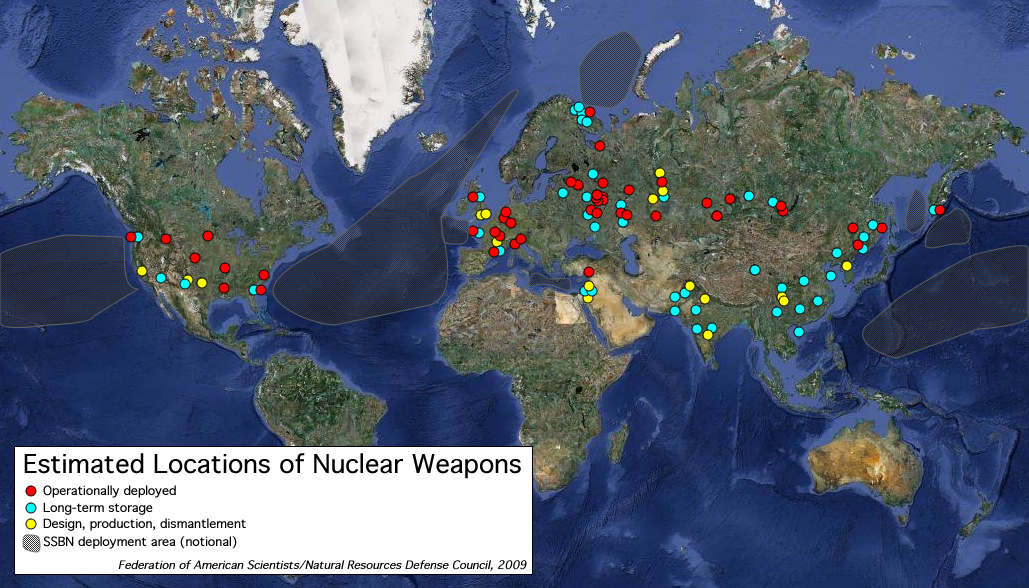
Some 23,300 nuclear weapons are stored at 111 locations around the world
.The world’s approximately 23,300 nuclear weapons are stored at an estimated 111 locations in 14 countries, according to an overview produced by FAS and NRDC.
Nearly half of the weapons are operationally deployed with delivery systems capable of launching on short notice.
The overview is published in the Bulletin of the Atomic Scientists and includes the July 2009 START memorandum of understanding data. A previous version was included in the annual report from the International Panel of Fissile Materials published last month.
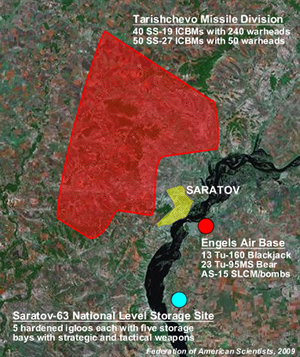
More than 1,000 nuclear weapons surround Saratov.
Russia has an estimated 48 permanent nuclear weapon storage sites, of which more than half are on bases for operational forces. There are approximately 19 storage sites, of which about half are national-level storage facilities. In addition, a significant number of temporary storage sites occasionally store nuclear weapons in transit between facilities.
This is a significant consolidation from the estimated 90 Russian sites ten years ago, and more than 500 sites before 1991.
Many of the Russian sites are in close proximity to each other and large populated areas. One example is the Saratov area where the city is surrounded by a missile division, a strategic bomber base, and a national-level storage site with probably well over 1,000 nuclear warheads combined (Figure 2).
The United States stores its nuclear weapons at 21 locations in 13 states and five European countries. This is a consolidation from the estimated 24 sites ten year ago, 50 at the end of the Cold War, and 164 in 1985 (see Figure 3).
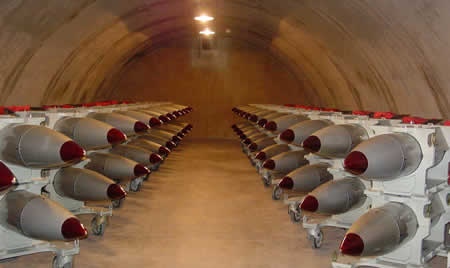
Approximately 50 B61 nuclear bombs inside an igloo at what might be Nellis Air Force Base in Nevada. Seventy-five igloos at Nellis store “one of the largest stockpile in the free world,” according to the U.S. Air Force, one of four central storage sites in the United States.
Europe has about the same number of nuclear weapon storage locations as the Continental United States, with weapons scattered across seven countries. This includes seven sites in France and four in Britain. Five non-nuclear NATO countries (Belgium, Germany, Italy, the Netherlands, and Turkey) still host U.S. nuclear weapons first deployed there during the Cold War.
We estimate that China has 8-14 facilities associated with nuclear weapons, most likely closer to the lower number, near bases with units that operate nuclear missiles or aircraft. None of the weapons are believed to be fully operational but stored separate from delivery vehicles at sites controlled by the Central Military Commission.
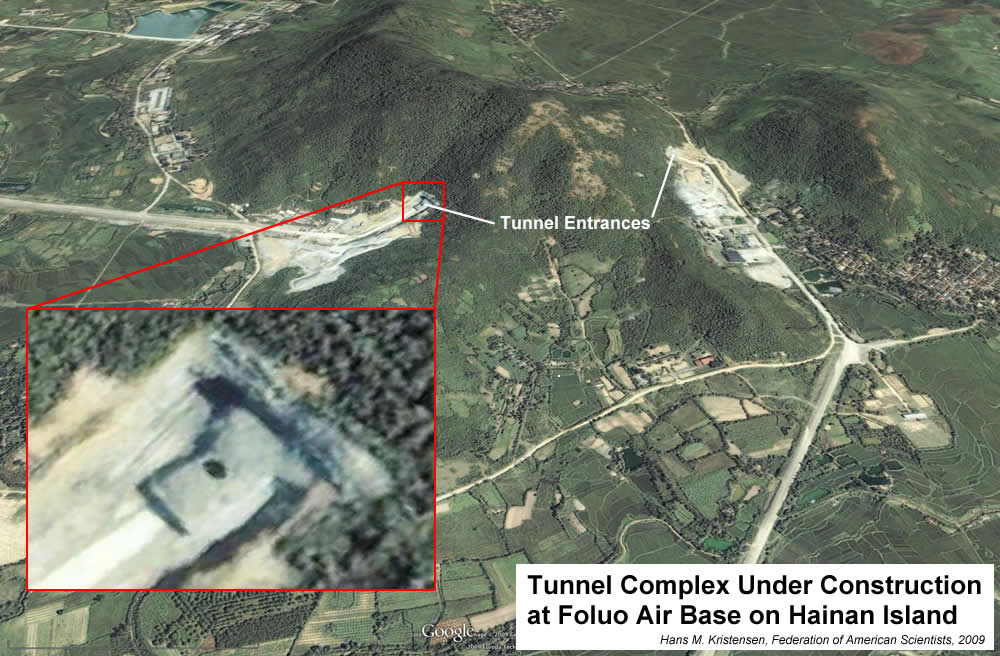
Where does China store nuclear warheads for its ballistic missile submarines? The naval base near Julin on Hainan Island has extensive underground facilities. An alternative to the base itself could potentially be a facility elsewhere on the island, such as Foluo Air Base where construction of an underground facility began five years before the first SSBN arrived at Hainan. Or are the weapons stored on the mainland? Click image to enlarge.
Israel probably has about four nuclear sites, whereas the nuclear storage facilities in India and Pakistan are – despite many rumors – largely undetermined. All three countries are thought to store warheads separate from delivery vehicles.
Despite two nuclear tests and many rumors, we are unaware of publicly available evidence that North Korea has operationalized its nuclear weapons capability.
Warhead concentrations vary greatly from country to country. With 13,000 warheads at 48 sites, Russian stores an average of 270 warheads at each location. The U.S. concentration is much higher with an average of 450 warheads at each location. These are averages, however, and in reality the distribution is thought to be much more uneven with some sites only storing tens of warheads.
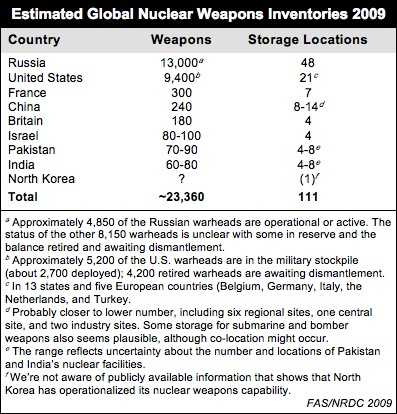
Finally, a word of caution is in order: estimates such as these obviously come with a great deal of uncertainty, as we don’t have access to classified intelligence estimates. Based on publicly available information and our own assumptions we have nonetheless produced a best estimate that we hope will assist the public debate. Comments and suggestions are encouraged so we can adjust the overview in the future.
This publication was made possible by a grant from Carnegie Corporation of New York and Ploughshares Fund. The statements made and views expressed are solely the responsibility of the author.
Iran Owned Part of Eurodif – Document Posted
By Ivanka Barzashka
FAS has posted a report on “Enrichment Supply and Technology Outside the United States” by S. A. Levin and S. Blumkin from the Enrichment Department of the Oak Ridge Gaseous Diffusion Plant, operated at the time by Union Carbide. The document, prepared for the U.S. Energy Research and Development Administration, reviews international uranium enrichment capacity and isotope separation technology as of 1977.
Apart from being of historical interest, the report explicitly states that Eurodif, a French-organized multinational enrichment consortium, was in part owned by Iran.
“The membership and apportionment of shares in Eurodif has been changeable. Presently, it is constituted by Belgium and Spain 11% each. Italy 25%, France 28% and Sofidif 25%, which is 40% owned by Iran and 60% by France.”
“In 1975, another consortium called Coredif with the same multinational membership as Eurodif but a different distribution of shares (Eurodif 51%, France 29% and Iran 20%) was organized to assess future nuclear demand and build a second Eurodif-type plant if the study results justified it.”
This is consistent with Iran’s claims that it owned shares of the enrichment company prior to the Islamic Revolution in 1979. This claim has been confirmed by the French government, but Iran has never received enriched uranium from the company.
The document has a disclaimer that “[i]t should not be presumed that the inclusion in this presentation of any reported information necessarily attests to its validity.”


